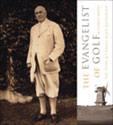The Evangelist of Golf: the Story of Charles Blair MacDonald
One of life’s little truisms is that “You can’t judge a book by its cover.”
To this bit of wisdom I’d like to add a modest corollary:
You can’t assume a book is only a coffee table book, judging from its size.
The Evangelist of Golf is a prime example. George Bahto assembled an enormously detailed collection of materials from private club libraries and other non-traditional sources to create a well-done history of the beginnings of golf architecture in America.
From the outside, the book looks just like a standard coffee-table golf book, popular this time of year with folks trying to find Christmas gifts for their golf-impaired loved ones.
It’s 10-inch x 11-inch proportions, however, include far more than the usual gorgeous photographs that fill the pages of similarly-sized tomes. Over the course of its 280 pages, Bahto provides a wealth of information about Macdonald, his courses, and his influence on American golf in matters going well beyond the creation of these vast playgrounds.
It’s a great companion piece to Macdonald’s own recently republished memoir, Scotland’s Gift. In part that’s because Bahto is not blind to some of Macdonald’s less admirable traits, although he certainly appreciates all that Macdonald did for the sport.
Macdonald came from a wealthy family, and a keen sense of entitlement seems to have been a major component of his frequently imperious behavior toward others.
Nonetheless, Macdonald managed to attract a few disciples who did not run away, notably Seth Raynor, whose own contributions to golf are a significant portion of this book. Bahto notes that there has been precious little previously written about Raynor, despite his work both with and independent of Macdonald. The omission is at least partially explained by Raynor’s own reticent personality, which is nicely portrayed in a reproduced interview.
Raynor was a stranger to golf until Macdonald retained the Princeton-educated surveyor/engineer to help him on the construction of the National Golf Links, on Long Island. The extended joint experience in creating that masterpiece led to a long and successful relationship, ending only with Raynor’s premature passing.
Bahto gives his readers a very good biography of Raynor, using to good effect what sparse materials were available to him.
The other significant contribution made with this book is in the detailed chapters devoted to some of Macdonald’s primary achievements in designing and building some of America’s best courses, helped by Raynor and several others.
Chapters Six through Twenty-Two are full of hole-by-hole descriptions, a fine collection of modern-day and old photographs, as well as detailed landscape drawings of such great layouts as The National Golf Links, Piping Rock Club, Shinnecock Hills, Mid-Ocean, and Yale University Golf Course.
Golf course architecture is primarily a visual medium, of course, and so the book’s large format is a big help on these sections, permitting the use of larger prints.
In addition, the stories of how Macdonald was lured into accepting these unpaid commissions are frequently amusing, proving that Macdonald’s quirks and weakness were obviously well-known to his contemporaries, who weren’t above exploiting them.
The book also includes two valuable additions. A time-line of events helps put into perspective Macdonald’s first attempts at building golf courses, his interaction with Raynor and other disciples, and the sudden impact of the Depression on the first golden age of golf course construction.
In addition, the composite listing of the courses designed and/or built in whole or in part by Macdonald, Raynor, and Charles H. Banks will surprise those who didn’t previously realize the impact of these men on the American golfing landscape.
Bahto did golf history a fine service with this maiden effort.
Review Date: November 30, 2003


